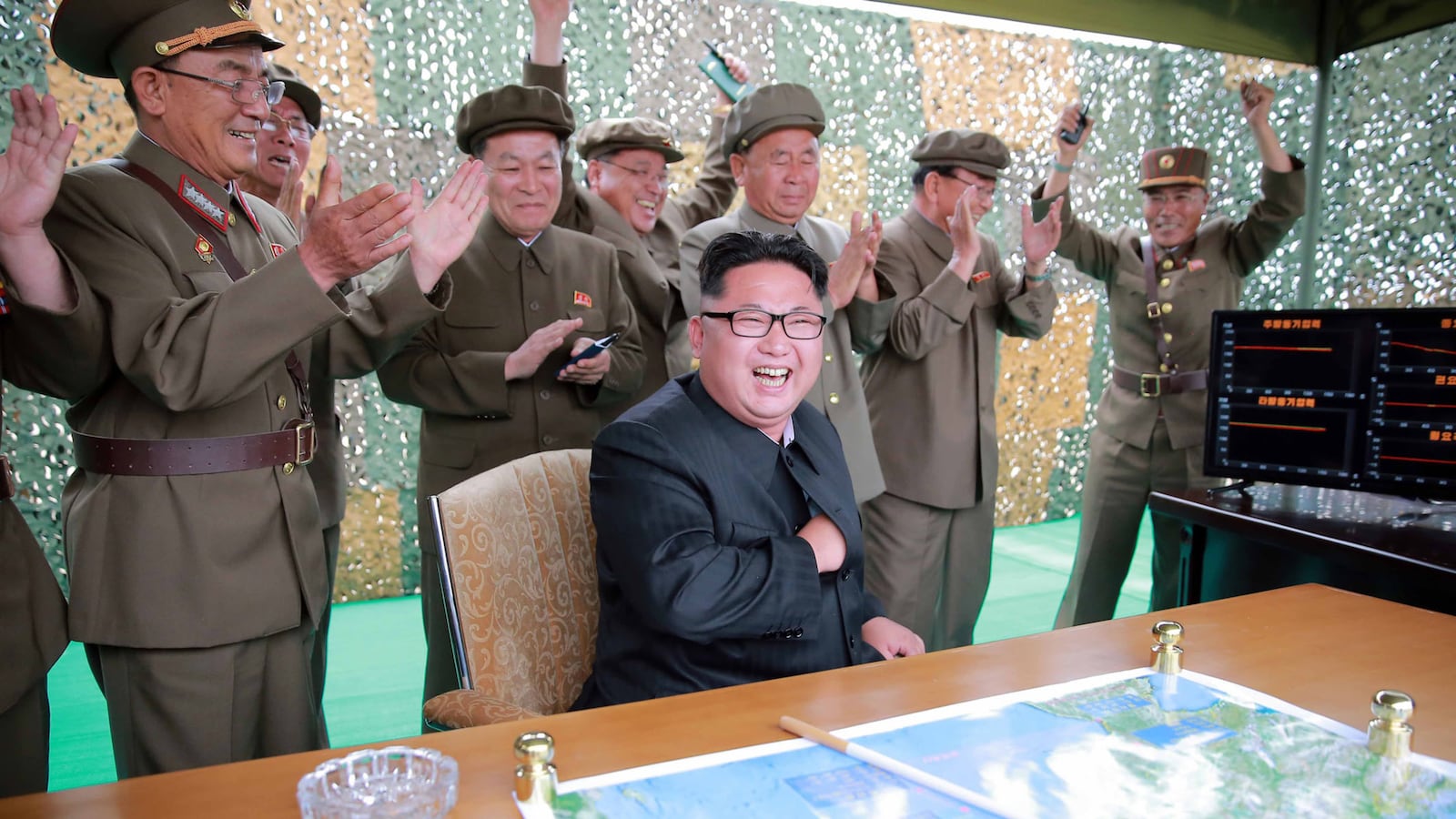North Korean leader Kim Jong Un is taking the gloves off, setting up a year that will likely include several missile tests and other demonstrations of military capability. The bout of diplomacy that began with the Trump administration and the South Korean government in early 2018 has been moribund for some time, but we now have the best indication from Pyongyang that the door on this chapter of rapprochement is shut.
Unusually, Kim Jong Un’s yearly New Year’s Day Address, taking after his grandfather’s annual January 1 speeches, appears to have been set aside this year in favor of a 4,300 word report, presented officially to the fifth plenum of the 7th Central Committee of the Korean Workers’ Party.
The document marks the culmination of several months of a strategic rethink that began earlier this year after the spectacular collapse of U.S.-North Korea talks in Hanoi, Vietnam.
One can say a lot in 4,300 words—and Kim Jong Un does. Optimists, including perhaps President Donald Trump, who already has called Kim a “man of his word,” may choose to ignore the sharp statements that indicate a dangerous turn in Pyongyang’s policy. But in Kim’s report the bottom line on talks with the United States is one of frustration, dejection, and defiance.
As explicit as ever, Kim ruled out the notion of diplomacy with the United States on disarmament, likening his nuclear force to his country’s “dignity” and categorically rejected the notion that this could be traded for a “brilliant transformation,” apparently alluding to the kind of proposition put forth days earlier by President Trump’s national security adviser, Robert C. O’Brien. If only Kim would give up nuclear weapons, O’Brien said, it would open up “a glorious path for the people of North Korea, where they can become like South Korea, and be a very prosperous, very wealthy country.”
Kim has other plans. As laid out in the plenum report, he sees the key to keeping his nuclear weapons and winning relief from economic sanctions that have constrained North Korea’s economy as more nukes, better missiles, and thus more leverage. Kim said that there was no sense in North Korea adhering to a now nearly two-year-long moratorium on nuclear and long-range missile testing “any longer,” setting up a new round of testing to showcase qualitative advancements in North Korean capabilities.
On economic sanctions, Kim delivered disappointing news to the Workers’ Party. Where in 2012, shortly after taking the reins of power from his father, Kim had said that he would never let North Korean people “tighten their belts again,” the plenum work report said that North Korea would have to hunker down and work hard to achieve “self prosperity even though we tighten our belts.”
Economic hard times aren’t new for Pyongyang, but Kim is resetting expectations. In 2017, there were lofty expectations that North Korea’s so-called “treasured sword”—what it poetically calls its own nuclear forces—would be the key to unlocking economic prosperity.
Back in April 2018, at the third plenum, Kim announced a series of unilateral measures relating to North Korea’s nuclear and missile programs—measures that were not presented in terms of a response to diplomacy with the United States. That plenum took place days before Kim’s first summit with South Korean President Moon Jae-in and after Trump had already accepted the prospect of meeting the North Korean leader face-to-face.
Kim announced that because North Korea’s development of nuclear weapons and long-range missiles was completed, testing was no longer necessary. The justification for the steps was thus technical, even if exaggerated. Those moratoria, however, were quickly treated as currency in negotiations, with Pyongyang emphasizing them as “denuclearization steps” that merited reward in the form of sanctions relief.
Though unwritten in any agreement, North Korea’s moratoria were met with a U.S.-South Korea “freeze” on large joint military exercises. Originally a solution favored by China and Russia in 2017, this “dual freeze” was the basis of reducing tensions that had soared in 2017.
This was the message that Kim Jong Un reiterated during his 2019 New Year’s Day Address, where the message to the United States was that North Korea had taken steps toward deescalating tensions and now it was Washington’s turn to reciprocate. The outcome of the truncated Hanoi summit in February made it clear the United States was not ready to offer sanctions relief.
And so, in April 2019, at the fourth plenum, Kim put in place his now famous end-of-year deadline for 2019, giving the United States one last chance to conduct a policy review and come around on the issue of granting North Korea partial sanctions relief for partial “steps” on denuclearization.
That change in heart never came; the final U.S.-North Korea working-level talks of any significance that took place in October 2019 were a final forum for Pyongyang’s negotiators to figuratively flip the table on what they considered to be an unacceptable package of U.S. proposals.
From then on, North Korea’s state propaganda apparatus was less than subtle as it indicated a dramatic shift was brewing. From Kim Jong Un’s two jaunts to Mount Paektu on a white horse to a series of year-end statements warning the United States of the impending deadline, including the now infamous “Christmas gift” promise, Pyongyang made it apparent that the door was quickly closing for a deal—if it hadn’t shut already.
China and Russia, Kim’s two closest great power partners, appear to have made noise at the United Nations Security Council in the final days of 2019 on economic sanctions relief in an attempt to perhaps stay Kim’s hand from his itchy missile-testing finger, but the plenum report suggests that whatever path North Korea will chart ahead will be of its own determination. Beijing and Moscow’s sensitivities are unlikely to cap North Korea’s appetite for risk.
What lies ahead will become known soon enough. Kim has promised a “shocking actual action,” suggesting that he’ll look to issue a wake-up call to Washington with a new demonstration of military capability as he sought to do in 2017 with his Fourth of July test of an intercontinental-range ballistic missile (ICBM).
Given that North Korea thrice tested ICBMs on a shortened, or “lofted,” trajectory into the Sea of Japan in 2017, something else is likely in the works to fit the bill for a “shocking” demonstration. Kim has hinted at a “new strategic weapon,” too, reiterating language from a statement released by North Korea’s Academy of Defense Science after a December rocket engine test. He said such a weapon would be witnessed by the world “in the near future.”
North Korea could demonstrate a bigger ICBM; a more capable ICBM (i.e., with multiple warheads or complex missile defense penetration aids); an ICBM using solid propellants, which could be launched more quickly than its 2017 systems; a more exotic weapon altogether, like a spin on the abortive Soviet Fractional Orbital Bombardment System; or look to conduct a nuclear test again—perhaps atmospheric instead of underground. (Such a threat was put on the table in September 2017 was never formally stricken.)
A new satellite launch could accompany a more explicitly militarized demonstration of capability, too. There are many options and Pyongyang is now technically adept enough and evidently risk-acceptant enough that none should be surprises. But Kim, by his own admission, is looking to shock the world.
Optimists might selectively point to parts of Kim’s plenum report that suggest the door to diplomacy remains open, but North Korea is not about to walk through that door anytime soon. 2019 was a reality check for Pyongyang, allowing it to test whether its nuclear capabilities were sufficient to win it respect as an equal at the negotiating table with the United States. The Hanoi summit demonstrated that whatever leverage it had acquired with its nuclear weapons and missile testing campaign through 2019 was insufficient to wake the United States up to the fact that North Korea was a nuclear power in its own right.
Fundamentally, what hasn’t changed is that North Korea is still not disarming or is not about to kowtow to American sanctions pressure. Just as every missile test in 2015, 2016, and 2017 was laying the groundwork for an eventual turn to diplomacy—if and only when North Korea became ready—so too will whatever demonstrations lie ahead in 2020 lay the foundation for the eventual next round of U.S.-North Korea engagement. In the meantime, we should expect a 2020 full of brinkmanship as Pyongyang continues to hone the blade of its “treasured sword.”





